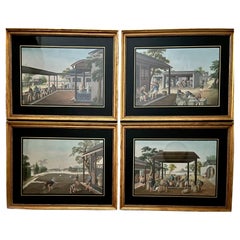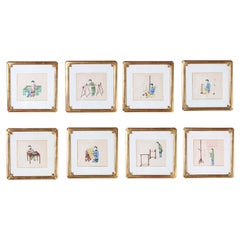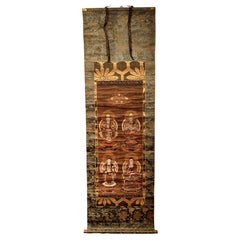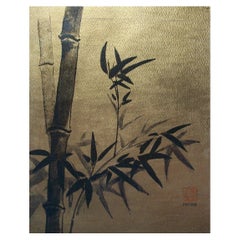Hand-Painted Paintings and Screens
to
93
308
129
626
52
5
18
9
6
5
4
1
1
1
1
1
78
286
262
57
105
60
29
10
1
15
2
4
10
9
6
4
2
297
256
247
167
164
603
499
304
165
54
683
650
661
18
2
2
2
1
Technique: Hand-Painted
B3 Japanese Antiques 6-panel, gold back, flower & bird duck, folding screen
Located in Niiza, JP
Material: paper, wooden frame
One sheet: W580×H1750mm,
unfolded size: W3520mm, 10kg
Folded size: W600×H1750×D105mm
Estimated packaging (sandwiched with 5mm plywood):
21cm x 70cm x 18...
Category
19th Century Japanese Antique Hand-Painted Paintings and Screens
Materials
Paper
Four Chinese Export Gouache Watercolors of Various Stages of Tea Production
By Puqua
Located in Nashua, NH
A Set of Four Beautiful and Elegant Chinese Export Gouache Watercolors,C. 1790 - 1820 displayed in beautiful gilded frames with bead decoration and magnificent wide black matting and...
Category
Early 19th Century Chinese Chinese Export Antique Hand-Painted Paintings and Screens
Materials
Paint, Glass, Wood
$23,600 Sale Price / set
20% Off
Set of Eight Chinese Watercolors of Working Women
Located in Palm Beach, FL
Rare antique set of eight Chinese watercolors depicting women in various occupations executed in a traditional delicate style on pith. Presented in a gilt carved wood Asian style fra...
Category
Early 20th Century Chinese Chinese Export Hand-Painted Paintings and Screens
Materials
Paint
Chinese Patriarch and Matriarch Ancestral Scroll Painting
Located in Rio Vista, CA
Magnificent Chinese scroll ancestor painting showing patriarch and matriarch of a high ranking status civil official. This unusual scroll depicts the dignitary couple seated below a ...
Category
Early 20th Century Chinese Qing Hand-Painted Paintings and Screens
Materials
Paper, Wood, Paint
$2,640 Sale Price
44% Off
Japanese Buddhist Painting, Hanging Scroll Painting
Located in Greenwich, CT
Japanese Buddhist Painting , Hanging Scroll Painting
Depicted Amituofo and Budhisattva in the painting sitting on the lotus crown seats. Bea...
Category
19th Century Japanese Antique Hand-Painted Paintings and Screens
Materials
Paper
$3,800 Sale Price
34% Off
MIEKO - Vintage Asian Style Painting on Paper - Signed - Japan - Late 20th C.
Located in Chatham, ON
MIEKO - Vintage Asian style painting on watercolor paper - signed with the artist's chop mark and name - Japan - late 20th century.
Excellent vintage condition - bleed through to th...
Category
Late 20th Century Japanese Anglo-Japanese Hand-Painted Paintings and Screens
Materials
Paint, Paper
$525 Sale Price
30% Off
Japanese Antiques A hanging scroll of peacock painted by Kado for Tokonoma
Located in Niiza, JP
Color on silk, Scroll head: wood
Size: Image size: 680(W) x 1600(H) [mm]
Scroll mounting: 850(W) x 2300(H) [mm]
Box size: 100(W) x 100(H) x 940(D) [mm] 1.8kg
A very well-writte...
Category
Mid-19th Century Japanese Antique Hand-Painted Paintings and Screens
Materials
Silk
Unique Hand Decorated "Romantic Family" Arts & Crafts Wood Settle Rhode Island
Located in South Burlington, VT
From an important thirty year old New England collection of hand decorated pyrography Arts & Crafts furnishings.
Unique work of art with a Rhode Island origin.
A romantic compositio...
Category
Early 20th Century American Arts and Crafts Hand-Painted Paintings and Screens
Materials
Wood
Gaboku Ogawa 'Abstract Japanese Calligraphy' MOMA 1953
Located in Sharon, CT
A very important work, both historically and aesthetically-"Getting madly drunk out of an earthenware goblet", by Gaboku Ogawa c.1953,
exhibited in the Museum of Modern Art show "Abstract Japanese...
Category
Mid-20th Century Japanese Mid-Century Modern Hand-Painted Paintings and Screens
Materials
Paper
Monumental Hand Painted Chinese Scroll With Ancestors In Custom Frame
Located in Bridgeport, CT
A monumental hand painted Chinese work depicting 11 male and female multi-generational ancestral figures. The portrait with one male in black attire and 3 men in black attire with bl...
Category
19th Century Chinese Qing Antique Hand-Painted Paintings and Screens
Materials
Silk, Acrylic, Wood, Paper
MOAZZAM ALI - Vintage South Asian Watercolor Painting - Pakistan - Late 20th C.
Located in Chatham, ON
MOAZZAM ALI - Vintage South Asian watercolor painting - untitled - signed lower right - unframed - Pakistan - late 20th century.
Excellent vintage condition - bright and strong colo...
Category
Late 20th Century Pakistani Hand-Painted Paintings and Screens
Materials
Paint, Paper
Japanese Antiques 4th Head Torii Kiyotada Silk color scroll Momotaro Ukiyo-e
Located in Niiza, JP
Torii School 7th Head [4th Head Torii Kiyotada] Silk color scroll Japan No. 1 Momotaro Ukiyo-e
Silk color
Scroll head: Wood
box: Paulownia wood
Image size: 410 (W) x 1150 (H) [mm]
S...
Category
19th Century Japanese Antique Hand-Painted Paintings and Screens
Materials
Silk, Paper
Middle Eastern Miniature Painting on Shell
Located in North Hollywood, CA
Hand Painted Asian Persian miniature painting on a sea oyster shell.
Middle Eastern Moorish design miniature painting on shell, very fine ...
Category
Mid-20th Century Asian Moorish Hand-Painted Paintings and Screens
Materials
Shell, Mother-of-Pearl
Indian Ceremonial Hindu Deity Hand-Painted on Canvas in Gilded Frame
Located in Yonkers, NY
A framed Indian ceremonial Hindu deity from the mid 20th century, hand-painted on canvas. Created in India during the midcentury period, this scene, hand-p...
Category
Mid-20th Century Indian Hand-Painted Paintings and Screens
Materials
Glass, Canvas
Late 19th century (Meiji period) painting depicting tiger
Located in Fukuoka, JP
Antique Tiger Painting on Paper – Meiji Period
A striking depiction of a tiger, painted on paper and signed by the artist. This work was originally part of a Japanese byobu folding ...
Category
Late 19th Century Japanese Meiji Antique Hand-Painted Paintings and Screens
Materials
Gold Leaf
Japanese Asian Edo Period Tosa School Original Painting Imperial Court Officials
Located in Studio City, CA
A beautiful and very engaging Edo Period (1603-1868) Japanese Tosa school original painting featuring two officials from the Imperial Court.
The Tosa school (土佐派,) of Japanese pai...
Category
1830s Japanese Edo Antique Hand-Painted Paintings and Screens
Materials
Wood, Paint, Paper
Chinese Early Qing Dynasty "Water and Land Ritual" Painting, 17th Century
Located in Austin, TX
An important Chinese 17th century early Qing Dynasty "Water and Land Ritual" painting, mineral pigment and ink on silk, mounted as a scroll, framed and glazed.
The painting depicting groups of heavenly court officials and deities descending from the clouds to participate in the Liberation Rite of Land and Water. The figures all wear full, sumptuous robes, complete with hats indicating their station. The blue, green, red, black and white of the robes decorated with gilt dragon and geometric designs.
This painting is interesting in that it incorporates Daosit deities and heavenly officials coming down to participate in the Buddhist rite. There are five distinct groups of figures, each with a small inscribed plaque. Some of the groups are identified as Tian Xian, or Heavenly Immortals.
The group at the bottom left are identified as the Sanguan Dadi, or Three Great Emperor-Officials. The Emperor of Heaven is dressed in blue robes with gilt painted dragons. The Emperor of Water wears black robes. The Emperor of Earth wears yellow robes...
Category
17th Century Chinese Qing Antique Hand-Painted Paintings and Screens
Materials
Silk, Glass, Giltwood, Paint
Elegant Horse Screen. In style of Kano Tanshin
By Kano Tanshin
Located in Fukuoka, JP
Ink on gold.
This continuation of equine grace unfolds across a stunning gold-leaf backdrop, capturing the essence of nobility that horses represent in Japanese lore.
The screen de...
Category
Late 18th Century Japanese Edo Antique Hand-Painted Paintings and Screens
Materials
Gold Leaf
Late 19th century (Meiji period) painting depicting tiger
Located in Fukuoka, JP
Antique Tiger Painting on Paper – Meiji Period
A striking depiction of a tiger, painted on paper and signed by the artist. This work was originally part of a Japanese byobu folding ...
Category
Late 19th Century Japanese Meiji Antique Hand-Painted Paintings and Screens
Materials
Gold Leaf
Late 19th century (Meiji period) painting depicting tiger
Located in Fukuoka, JP
Antique Tiger Painting on Paper – Meiji Period
A striking depiction of a tiger, painted on paper and signed by the artist. This work was originally part of a Japanese byobu folding ...
Category
Late 19th Century Japanese Meiji Antique Hand-Painted Paintings and Screens
Materials
Gold Leaf
Japanese 2-Panel 'Shunga' Screen with Finely Painted Erotic Depictions of Lovers
Located in Prahran, Victoria
A very finely painted two panel 'shunga' screen with scenes of naked erotic lovers in union.
The scene on the left panel simply depicts the lovers in ...
Category
Mid-20th Century Japanese Showa Hand-Painted Paintings and Screens
Materials
Wood, Paper
"19th-Century Pig Portrait: Charming Farm Animal Art"
Located in Southall, GB
This charming 19th-century pig portrait captures the endearing character and personality of this farm animal with exceptional detail and warmth. The artist’s skilled brushwork highli...
Category
19th Century English Antique Hand-Painted Paintings and Screens
Materials
Glass
Large Antique Chinese Deity Scroll Painting 19th C
Located in Big Flats, NY
An oversized antique Chinese scroll painting offers depiction of deity with figures, 19th century
Measures - 69" x 26.5"
Catalogue Note: ...
Category
19th Century Asian Antique Hand-Painted Paintings and Screens
Materials
Paper
$760 Sale Price
20% Off
Showa Golden Mallow Screen
Located in Fukuoka, JP
This exquisite two-panel screen from the Showa period features a lush depiction of mallows in vibrant hues set against a luxurious golden background. The mallow flower, known in Japa...
Category
20th Century Japanese Showa Hand-Painted Paintings and Screens
Materials
Gold Leaf
19th-Century Study of Bumble Bees: A Collection of Nine Detailed Paintings
Located in Southall, GB
This charming 19th-century painting presents a detailed study of nine bumblebees, each meticulously rendered to capture the delicate beauty and intricate anatomy of these fascinating...
Category
19th Century English Antique Hand-Painted Paintings and Screens
Materials
Glass
Lovely Pair of Antique Chinese Ancestral Portrait Hand Painted Glass Paintings
Located in West Sussex, Pulborough
Royal House Antiques
Royal House Antiques is delighted to offer for sale this lovely pair of Antique Chinese Ancestral Portraits w...
Category
20th Century Chinese Chinese Export Hand-Painted Paintings and Screens
Materials
Glass
$1,671 Sale Price / set
20% Off
Vintage kimono textile art "View from the Window ~Maple&Plum~" by ikasu, Japan
By Kimono ikasu
Located in Setagaya City, JP
This work is a glorious nod to buddhist temples circle windows, with beautiful Japanese garden scape seen outside. Golden leaf on the border of a frame is an expression of light goin...
Category
1930s Japanese Japonisme Vintage Hand-Painted Paintings and Screens
Materials
Gold Leaf
Japanese Signed painting on silk depicting Bamboo and Bird
Located in Fukuoka, JP
Japanese Signed painting on silk depicting Bamboo and Bird
This exquisite painting on silk depicts a beautiful bamboo and a bird, signed by the talented artist Waichi.
The pi...
Category
20th Century Japanese Hand-Painted Paintings and Screens
Materials
Silk, Wood
A Late C19th Chinese Gouache Painting On Pith Paper
Located in London, GB
A Charming Late C19th to Early C20th Chinese Gouache Painting on Pith Paper. Featuring an array of colourful Koi Carp swimming amongst reeds. Nicely executed with wonderful strong co...
Category
Late 19th Century Chinese Chinese Export Antique Hand-Painted Paintings and Screens
Materials
Paint, Paper
Chinese Reverse Painted Glass and Hardwood Table Screen
Located in Austin, TX
An unusual table screen featuring a reverse glass painted portrait of a young noble lady set into a hardwood frame and stand.
The beautiful maiden has a roun...
Category
Mid-19th Century Chinese Qing Antique Hand-Painted Paintings and Screens
Materials
Glass, Hardwood
Late 19th century (Meiji period) painting depicting tiger
Located in Fukuoka, JP
Antique Tiger Painting on Paper – Meiji Period
A striking depiction of a tiger, painted on paper and signed by the artist. This work was originally part of a Japanese byobu folding ...
Category
Late 19th Century Japanese Meiji Antique Hand-Painted Paintings and Screens
Materials
Gold Leaf
Framed Japanese Brush Painting of Two White Geese Swimming in a Pond
Located in Greenwich, CT
Framed Japanese brush painting of two white geese swimming in a pond,
19th century, ink on paper, original brocade mount.
Overall size with frame: 58" height 26" width
Image size...
Category
19th Century Japanese Meiji Antique Hand-Painted Paintings and Screens
Materials
Paper
$3,500 Sale Price
22% Off
A six-panel folding screen depicting scenes from the Tales of Genji
Located in Milano, IT
Six-panel folding screen painted on paper, with pigments, gold dust and gold leaf, depicting two scenes from the Tales of Genji. The landscape is dominated by a Matsu with sinuous br...
Category
19th Century Japanese Antique Hand-Painted Paintings and Screens
Materials
Paper
Japanese Two Panel Screen: Moon and Flowers
Located in Hudson, NY
Showa period (1926 - 1989) painting with a strong design of exotic lilies and a cluster of nadeshiko (dianthus) under a silver moon on gold. This painting has a modern flair, which ...
Category
20th Century Japanese Hand-Painted Paintings and Screens
Materials
Silver
Japanese Two Panel Screen Manchurian Crane and Turtles
Located in Hudson, NY
In Japan, cranes symbolize fidelity as they mate for life and turtles symbolize longevity. Additionally, this screen also has the Japanese motif of sho-chiku-bai, or the three friends of winter (pine, plum, and bamboo). So called the three friends of winter because all three flourish during the cold months. This screen was originally fusuma doors...
Category
Mid-19th Century Japanese Edo Antique Hand-Painted Paintings and Screens
Materials
Paper
Set of Five Antique Chinese Watercolors on Silk
Located in Palm Beach, FL
Intriguing set of five Chinese watercolor paintings on silk depicting men occupied in their trades, executed in a soft delicate technique and presented under glass in four wood frame...
Category
Early 20th Century Chinese Chinese Export Hand-Painted Paintings and Screens
Materials
Silver Leaf
$4,100 / set
Showa Delicate Floral Screen
Located in Fukuoka, JP
This graceful two-panel screen captures the essence of summer with its subtle depiction of slender grasses and fine lines, artfully arranged against a golden background. The screen e...
Category
20th Century Japanese Showa Hand-Painted Paintings and Screens
Materials
Gold Leaf
Framed Chinese Painting of Landscape of Scholars Playing the Game
Located in Greenwich, CT
refined Chinese brush painting of landscape, scholars playing game of Go in bamboo grove. ink and color on silk, 19 century
The first photo has some vertical reflections on the plex...
Category
19th Century Chinese Antique Hand-Painted Paintings and Screens
Materials
Silk
19th-Century Avian Collection: Set of Five Exquisite Bird Paintings
Located in Southall, GB
This captivating set of five 19th-century bird paintings showcases the remarkable beauty and diversity of avian life through masterful artistry. Each painting features a different bi...
Category
19th Century English Antique Hand-Painted Paintings and Screens
Materials
Glass
Set of Four Chinese Immortals Screen Paintings, c. 1850
Located in Chicago, IL
Since the 12th century people in China have used folding screens and doors to partition and decorate their homes—the vivid scenes backing the screens added life and color to a room. ...
Category
Mid-19th Century Chinese Qing Antique Hand-Painted Paintings and Screens
Materials
Paper
Large Antique Chinese Hand Painted Wallpaper Section in Carved Hardwood Frame
Located in Austin, TX
A wonderfully charming large and colorful Chinese hand painted wallpaper section in a carved and shaped hardwood frame. The wallpaper dates to the first half of the 20th century or e...
Category
Early 20th Century Chinese Chinese Export Hand-Painted Paintings and Screens
Materials
Hardwood, Paper
Set of Four Sliding Doors (Fusuma): Wild Grasses
Located in Hudson, NY
Meiji period (1868 - 1912) four separate sliding doors (fusuma) with Shijo School paintings of wild grasses. Can be hung separately, or together as shown. Signature reads: Kogetsu....
Category
20th Century Japanese Hand-Painted Paintings and Screens
Materials
Bronze
Lavish 19th Century Maruyama School Peacock Screen
Located in Fukuoka, JP
Lavish 19th Century Maruyama School Peacock Screen
Period: 19th Century
Size: 360 x 173 cm (141.7 x 68.1 inches)
SKU: PF12
Behold the grandeur of the ...
Category
19th Century Japanese Edo Antique Hand-Painted Paintings and Screens
Materials
Wood, Paper
19th-Century Hand-Painted Aquatic Collection, Fish Illustrations
Located in Southall, GB
This captivating set of 19th-century hand-painted illustrations beautifully captures the vibrant diversity of aquatic life. Each piece features a meticulously detailed depiction of v...
Category
19th Century English Antique Hand-Painted Paintings and Screens
Materials
Glass
Mughal Miniature of Shah Jahan on a Leisure Stroll, 19th Century
Located in Islamabad, PK
The Mughal miniature painting, meticulously crafted with a single-hair brush on fine rice paper, captures a serene and elegant scene of Emperor Shah Jahan taking a leisurely stroll o...
Category
Mid-19th Century Indian Anglo Raj Antique Hand-Painted Paintings and Screens
Materials
Paint, Paper
Meiji Chrysanthemum Masterpiece
Located in Fukuoka, JP
Step into a world of timeless beauty with our exceptional six-panel screen from the Edo-Meiji period. In impeccable condition, each panel features stunning paintings of chrysanthemum...
Category
19th Century Japanese Meiji Antique Hand-Painted Paintings and Screens
Materials
Gold
Japanese Antiques Hanging scroll, silk, crane
Located in Niiza, JP
Hanging scroll, silk, crane
Image size: 420 (W) x 1270 (H) [mm] Scroll size: 560 (W) x 2120 (H) [mm]
Box size: 80 x 75 x 630 mm, 830 g
Colored cloth and silk, wooden tip
The crane...
Category
19th Century Japanese Antique Hand-Painted Paintings and Screens
Materials
Silk
Fine Mughal Painting of a ‘Lion at Rest’, North India, Early 19th Century
Located in Amsterdam, NL
A Mughal painting of a ‘Lion at rest’
North India, early 19th century
?
Watercolour on paper, H. 46.5 x W. 68 cm
?The present painting is a large...
Category
Early 19th Century Indian Antique Hand-Painted Paintings and Screens
Materials
Paper
VIntage kimono textile art "Geometry ~Marble~" by ikasu Gold, White, Grey, Japan
By Kimono ikasu
Located in Setagaya City, JP
This work is inspired by traditional Japanese nature motifs symbolism, and is framed in paulownia wood originally used for a kimono chest-of-drawers.
It is elegantly framed with pau...
Category
1960s Japanese Japonisme Vintage Hand-Painted Paintings and Screens
Materials
Silk, Wood
Chinoiserie Palm Oval Paintings
Located in Sturminster Marshall, Dorset
A pair of carved giltwood Chippendale crossed palm frames, with inset hand-painted chinoiserie portraits of 18th century oriental nobility.
We a...
Category
21st Century and Contemporary English Chippendale Hand-Painted Paintings and Screens
Materials
Gold Leaf
$6,685 / set
Late 19th century (Meiji period) painting depicting tiger
Located in Fukuoka, JP
Antique Tiger Painting on Paper – Meiji Period
A striking depiction of a tiger, painted on paper and signed by the artist. This work was originally part of a Japanese byobu folding ...
Category
Late 19th Century Japanese Meiji Antique Hand-Painted Paintings and Screens
Materials
Gold Leaf
Antique kimono textile art " Plum Blossom Night ~Resilience~ " by ikasu Japan
By Kimono ikasu
Located in Setagaya City, JP
This artwork uses antique fabric from Taisho era (early 1920ies) kimono and paulownia wood taken from antique kiritansu - chest-of-drawers used initially to keep kimonos.
It is eleg...
Category
1920s Japanese Japonisme Vintage Hand-Painted Paintings and Screens
Materials
Silver Leaf
Tall Vintage Chinese Export Reverse Glass Painted Hardwood Framed Hanging Panel
Located in Austin, TX
A very large vintage Chinese export reverse glass painted figural hanging wall panel in a carved hardwood frame, early to mid-20th century...
Category
Mid-20th Century Chinese Qing Hand-Painted Paintings and Screens
Materials
Glass, Hardwood
A japanese folding screen decorated with a naturalistic scene
Located in Milano, IT
Byōbu folding screen, 屏風, six panels with gold leaf background, decorated with a naturalistic scene of elegant simplicity, depicting flowers and a stream.
The composition depicts a s...
Category
Late 19th Century Japanese Antique Hand-Painted Paintings and Screens
Materials
Paper
Antique kimono textile art " Kobachi ~ Coral Collection ~ " by ikasu Pink, Japan
By Kimono ikasu
Located in Setagaya City, JP
This work is inspired by the coral color palette, and is framed in paulownia wood originally used for a kimono chest-of-drawers.
In this artwork, the aim was to capture the wide pal...
Category
1920s Japanese Japonisme Vintage Hand-Painted Paintings and Screens
Materials
Silk, Wood
Early 20th century (Meiji period) crane scroll. Original storing box
Located in Fukuoka, JP
This Meji -Taisho period painting captures a serene moment in nature, depicting graceful bird resting. Painted on silk . Signed. Includes original storage box
Size: Overall 138/...
Category
Early 20th Century Japanese Meiji Hand-Painted Paintings and Screens
Materials
Silk, Paper
Japanese Painting, 17th Century, Tale of Genji, Tosa School
Located in Kyoto, JP
Illustration to an unidentified chapter of the Tale of Genji (Genji Monogatari)
Tosa School (second half of the 17th Century)
Ink, pigment, gofun and...
Category
Late 17th Century Japanese Edo Antique Hand-Painted Paintings and Screens
Materials
Gold Leaf
Antique kimono textile art " Kobachi ~Marine Collection~ " by ikasu Blue, Japan
By Kimono ikasu
Located in Setagaya City, JP
This work is inspired by the blue color palette, and is framed in paulownia wood originally used for a kimono chest-of-drawers.
In this artwork, the aim was to capture the wide pale...
Category
1920s Japanese Japonisme Vintage Hand-Painted Paintings and Screens
Materials
Silk, Wood
1939 years Japanese six-panel "Spring Reverie" Screen
Located in Fukuoka, JP
Spring Reverie
Period: Showa
Year: 1939
Size: 358 x 173 cm (140.9 x 68.1 inches)
SKU: SD230
This exquisite 6-panel screen captures the ethereal beauty of spring through the depict...
Category
20th Century Japanese Showa Hand-Painted Paintings and Screens
Materials
Wood, Paper
Japanese Asian Signed Four-Panel Folding Byobu Showa Screen of Performing Geisha
Located in Studio City, CA
A gorgeous four-panel Japanese Byobu folding screen depicting a scene of seven entertaining geisha women, perhaps in a bamboo garden of the Imperial court. The vibrant, rich colors...
Category
20th Century Japanese Showa Hand-Painted Paintings and Screens
Materials
Gold Leaf
Recently Viewed
View AllMore Ways To Browse
Buddhist Scroll
Chinese Coromandel Lacquer Screen
Chinese Screen Stone
Antique Chinese Hand Fans
Antique Face Screens
Cherry Blossom Screen
Asian 3 Panel Screen
Antique Fence Panels
Asian Crane Panel Art
Chinese Four Panel Lacquer Screen
Chinese Lacquer Antique Screens
Asian Art Painting Pair Wood Panel
Carved Wood Screen Doors
Chinese Gold Leaf Screen
18th Century Japanese Silk Painting
Asian Folding Screen Birds
Chinese Window Panel
Crane Bird Painting





